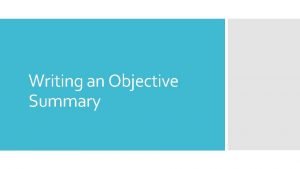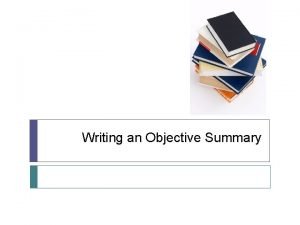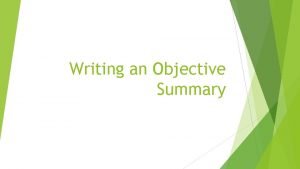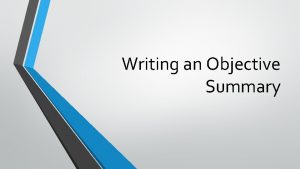Unit 4 Summary Writing Approach to Summary Writing





- Slides: 5

Unit 4: Summary Writing Approach to Summary Writing �. Read (passage) Read the passage to get a general understand of what Read the passage again and highlight the points the author is trying to convey. – that you think are appropriate to use in Read the question asked by the answering the examiner’s questions. examiner so that you have a better Read (question) about the understanding - information you need to get from the passage. Place the points in order of priority Read the passage (2 nd time) – Order the points Ensuring that the information you provide answers the question asked by the examiner. – Begin writing:

Unit 5: � Comprehension

Comprehension Strategies Make Connections Ask Questions Co mp reh !!!! en !!!! sio !! n Visualize Determine Text Importance Make Inferences Synthesize

Make Connections (e) discern themes, opinions, or perspectives, Readers connect the topic or information to what they (f) pinpoint problems and solutions, already know about themselves, about other texts, and (g) name steps in a process, about the world. (h) locate information that answers specific questions, Readers ask themselves questions about the text, their or reactions to it, and the author's purpose for writing it. (i) summarize. Ask Questions Visualize Readers make the printed word real and concrete by creating a “movie” of the text in their minds. Determine Text Importance Readers should: Make Inferences Readers merge text clues with their prior knowledge and determine answers to questions that lead to conclusions about underlying themes or ideas. Synthesize Readers combine new information with existing (a) distinguish between what's essential versus what's knowledge to form original ideas, new lines of interesting, thinking, or new creations. (b) distinguish between fact and opinion, (c) determine cause-and-effect relationships, (d) compare and contrast ideas or information,

Poetry Writing �Poetry deals with particular things in concrete language, since our emotions most readily respond to these things. Types of Poetry Lyric Poetry Narrative Poem Descriptive Poem It is any poem with one speaker (not necessarily the poet) who expresses strong thoughts and feelings. Most poems, especially modern ones, are lyric poems. It is a poem that tells a story; its structure resembles the plot line of a story [i. e. the introduction of conflict and characters, rising action, climax and the denouement It is a poem that describes the world that surrounds the speaker. It uses elaborate imagery and adjectives. While emotional, it is more "outwardfocused" than lyric poetry, which is more personal and introspective.









